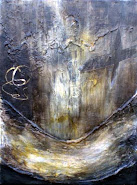Just been looking at the images of the professional artists compared to ours, i'm now thoroughly depressed, the end result is so much more complete than ours, and i don't know how to get that finished quality, undoubtedly it is not just down to the final stages of a painting, but i feel certain that there are techniques that can be applied to these final stages, things that are learnt, even if this is just learning what to particularly look for. However, it is important to note that the quality of the painting has to be of a high standard throughout, and this clearly impacts on the finish. One way i am attempting to rectify this problem at the moment is by taking more care about the use of whites. Earlier i would have simply used titanium for almost everything and then maybe a bit of zinc if i wanted a transparent veil to float over the surface. Now i am taking particular note of the varying and subtle qualities of each. I have found that for general mixing, I've really started to appreciate the tit. white bound by safflower oil. this is the most neutral (white) white available, linseed oil has a very slight yellowing quality. It is the most brilliant of the whites. I have started to use zinc white a lot more for mixing, it is useful for particular colours that side on the cool of their colour range and because it has cooler undertones itself, its mixes are so clean and fresh. Then finally i have started to use cremnitz white, most of the time bound with walnut oil, which gives it a wonderful silken quality, it has the most fantastic subtle luminosity which is why it is sometimes known as silver white and is brilliant when you want to lay down a pure white that ahs real life inside it. good for clouds and glints dropped on jewellery.
If anybody else has any information on techniques that lead towards the refinement of the finished product, i'd be incredibly grateful.
Our Artwork
Subscribe to:
Post Comments (Atom)




































No comments:
Post a Comment